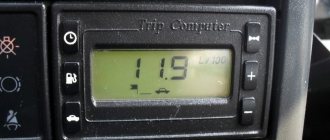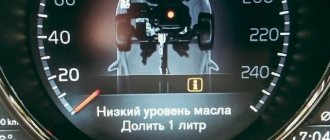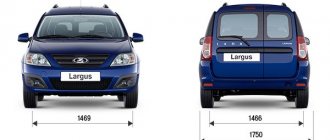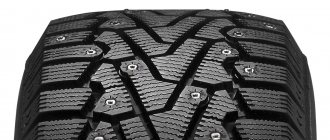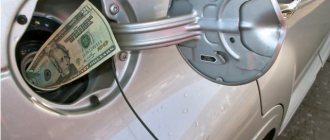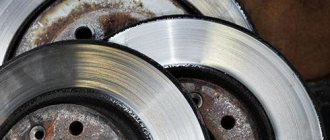Regulatory regulation
The document that sets fuel consumption standards is Order of the Ministry of Transport No. AM-23-r dated March 14, 2008. Organizations approve local standards for the write-off of fuels and lubricants and fuel consumption standards according to Order of the Ministry of Transport 23-r: it was not changed in 2022, the latest edition was released in September 2022. The changes were made by Order of the Ministry of Transport of the Russian Federation No. IA-159-r dated September 20, 2018.
The Ministry of Transport recommends calculating the volume of gasoline consumed as follows:
Where:
- QH - fuel consumption,
- HS is the basic fuel consumption rate per 100 km according to the Order of the Ministry of Transport for 2022 (set in l/100 km);
- S—car mileage;
- D is the correction factor.
The order establishes basic indicators for most car models. The current table of fuel consumption by car brands for 2022 is differentiated by type of vehicle (passenger cars, trucks, etc.) and contains thousands of items. Its beginning looks like this:
The correction factor is calculated based on surcharges to the base tariff established in connection with operating conditions.
Warming up is required
What factors influence efficiency? Before driving in cold weather, the engine must be warmed up. Already at a temperature of about -5 degrees, it is necessary to double the warm-up time. If at positive temperatures one and a half to two minutes is enough for the pump to pump the oil, then in winter you need to stay for 3-5 minutes in the yard until the heat from the power unit transfers to the gearbox. Naturally, at idle, fuel consumption increases.
Article on the topic
Beat the cold. How to start a car in 40-degree frosts? If the car is equipped with an old carburetor engine, then a long warm-up period is required at the parking lot. Such units are configured for one mode of mixture preparation and cannot adapt to rapid temperature changes. This means that fuel combustion during a cold start will be incomplete and will release by-products and soot. When started in cold weather, such an engine sharply loses traction. It simply cannot give the car the desired dynamics in the first minutes of operation. The engine falters, the car jerks, does not accelerate, and responds to the accelerator pedal with delays.
To prevent the carburetor engine from stalling, a mechanical regulator is used to enrich the mixture, popularly known as choke. Usually it is a mechanical lever in the car interior that partially blocks the air supply hole. There is more gasoline in the combustible mixture, the car does not stall when warming up, but consumption increases. After the power unit reaches operating temperatures, the suction is removed and consumption decreases.
From what date do winter standards apply?
When the temperature drops below +5 °C, a winter supplement is applied, the duration of which depends on the region. There is no single standard for the date on which the transition to winter fuel consumption standards in 2022 by region will take place this winter. The transition is carried out depending on the climate zone. Both winter and summer fuel consumption standards depend on the climate of the place of operation - from which month they are introduced. In the central part of Russia, the winter premium is up to 10% and is introduced for five months: from November 1 to March 31. In the northern regions, the premium reaches 20% and applies up to 7 months a year.
The table shows winter fuel consumption rates by region in 2021:
| Subject of the Russian Federation or part thereof | Number of months and period from which to which winter period for cars in the region | Maximum amount of winter allowances, no more, % |
| Moscow | 5 01.11–31.03 | 10 |
| Belgorod region | 4 15.11–15.03 | 7 |
| Bryansk region | 5 01.11–31.03 | 10 |
| Vladimir region | 5 01.11–31.03 | 10 |
| Voronezh region | 5 01.11–31.03 | 10 |
| Ivanovo region | 5 01.11–31.03 | 10 |
| Kaluga region | 5 01.11–31.03 | 10 |
| Kostroma region | 5 01.11–31.03 | 10 |
| Kursk region | 5 01.11–31.03 | 10 |
| Lipetsk region | 5 01.11–31.03 | 10 |
A complete list of winter fuel consumption standards and the timing of their application in 2021 by climatic zone is presented in Appendix 2 to the methodological recommendations for establishing fuel consumption standards.
To switch to winter coefficients, it is recommended to issue an order.
Reasons for high fuel consumption
Warming up
Leave the car in the cold for several hours, and the fluids in the transmission will thicken. To warm up this cold liquid, the engine needs to expend more energy, so it is fueled by gasoline.
If you take your car in the morning to get to work, leave it there until the evening, and then drive home, then you have to intensively warm up the car twice a day. If you also need to go somewhere during your lunch break, then add additional heating.
All this increases consumption by about 5-10%.
Stove
Are you turning it on? Otherwise! Who wants to ring bells in their own car? You also heat the windows, seats, and side mirrors. By the way, this is 4-6% above normal fuel consumption.
Winter tires
The tread of winter “shoes” is much more prominent than summer ones, but the material itself is softer. Thanks to this idea, driving on a road petrified by cold becomes safer, but the resistance to rolling is higher. To overcome the resistance, the engine is again forced to strain and eats a lot.
Slipping
Driving through slushy snow or snowdrifts is an obstacle course, and in off-road conditions the engine has to operate at high speeds. It is calculated that if a car stalls and tries to get out for 40-60 minutes, it will burn up the same amount of fuel as it spends on one ordinary summer day. Here we need to say “thank you” to the utility workers who are supposed to clean the roads.
Light
The winter sun is working hard - it gets light late and dark early. That's why our headlights are on almost constantly, and this also eats up fuel - it seems like a little at a time, but in total it turns out to be an indecent amount.
Other types of allowances to basic standards
In addition to seasonal operating conditions, the order AM-23-r establishes the following reasons for increasing the basic tariffs for the consumption of fuel and lubricants:
- work in mountainous areas (from 5 to 20%);
- operation in populated areas with a large population (from 5 to 35%);
- driving at a reduced speed (for example, at a speed below 20 km/h - up to 35%);
- operation over 5 years and mileage over 100,000 km (5%), over 8 years and 150,000 km (10%);
- use of air conditioning (up to 10%).
In some cases, the basic standards are lowered. For example, when operating on flat terrain outside populated areas.
Energy consumption
In winter, the stove fan operates at full power, along with heated windows, seats, and much more. When the windows fog up, you have to turn on the air conditioning. All these devices require energy, the production of which requires fuel. The battery charge decreases and the generator is actively working.
In the summer, of course, a lot of electricity is spent on the operation of the air conditioner, but in our summer it is turned on less often than the stove and various heating systems in our winter. Only the most frost-resistant ones will be able to save, and it’s difficult to call saving ten liters per season.
What does tax law say?
The basic fuel consumption rate established by the Ministry of Transport is not mandatory. The Tax Code does not contain requirements for the need to regulate the consumption of fuel and lubricants. The organization has the right to write off fuel costs for vehicles in the amount of actual costs. This rule applies both to OSNO when calculating income tax, and to the simplified tax system.
This position is currently adhered to by the Ministry of Finance (letter No. 03-03-06/1/2875 dated January 27, 2014). The regulatory authorities indicate that the costs of fuel and lubricants must be economically justified and documented, and no requirements for their standardization have been established in the Tax Code of the Russian Federation. But the taxpayer has the right to establish the amount of write-off, based on the methodological recommendations of the Ministry of Transport No. AM-23-r.
ConsultantPlus experts discussed how to calculate fuel consumption according to standards. Use these instructions for free.
For quite a long time, regulatory authorities held the opposite point of view. Back in 2010, in letter No. 03-03-06/2/57 dated 09/03/2010, the Ministry of Finance indicated the taxpayer’s obligation to apply fuel consumption standards established by the Ministry of Transport. But then, under the influence of judicial practice, the Ministry of Finance changed its point of view. And now, in order to apply other write-off standards, the taxpayer must document the legality of writing off fuel and lubricants in the amount in which they were actually consumed.
Reason for high fuel consumption
And here’s another reason for you, as it turns out, almost an anecdote. Since I have an automatic transmission, I was advised to leave the car in the parking lot in the winter not in the “P” position, but in neutral. I started doing this and noticed that the on-board computer was giving huge values for consumption, although it was expected that it would be the other way around.
Should I switch the automatic transmission to neutral at a traffic light?
When I found out, I laughed for a long time. It turns out that during parking, consumption is calculated by time - liters per hour, although the car is not moving. But computer brains show everything in liters per hundred kilometers. So I sat down in surprise.
They also told me that whoever advised leaving the car in neutral in winter should personally spit in the borscht. So who is right?
How to develop your own standards
Organizations are not required to follow the standards established by the Ministry of Transport in Order No. AM-23-r. In its internal regulatory documents, the company has the right to establish accounting for fuel and lubricants in costs in the volumes actually consumed. And use as supporting documents for the purchase of fuel and waybills indicating the operation of the car.
However, for the purpose of internal control over the consumption of fuel and lubricants, the organization has the right to develop and establish its own standards. For this they rely on:
- to the standards of the Ministry of Transport;
- on the manufacturer's recommendations;
- to their own control figures, approved by a special commission based on control measurements.
The same order states when switching to the summer fuel consumption rate, what other correction factors are applied depending on the operating conditions of the vehicle.
You have to pay for heat
Another important factor affecting a car's energy consumption is the use of the stove. The lower the air temperature, the more you turn the climate control regulator into the red zone. If the car is equipped with smart climate control, then the automation itself regulates energy consumption to heat the interior. Thus, in winter the stove works constantly, taking away precious heat from the cooling system and increasing fuel consumption by about another 4-6%.
In addition, energy is needed not only for the stove drive, but also for the generator, which works much more in cold weather than in the summer heat. The battery loses up to half its charge in cold weather and needs to be recharged.
Question answer
How to drive correctly to protect your shock absorbers in the cold?
Reducing carburetor consumption
A carburetor car is less economical than an injector, and therefore has more customization options regarding fuel consumption. But you shouldn’t be under the illusion that you can adjust the flow rate yourself, thanks to all these “twirls” on the carburetor. Without understanding the carburetor, you will get the opposite effect.
Timely replacement of spark plugs and good high-voltage wires can save your money. Improper sparking leads to incomplete combustion of gasoline, the remains of which simply fly out into the chimney. This also applies to correctly set ignition.
Why does a car consume more fuel in winter?
Fuel consumption increases in winter for several reasons. First: frost. Freezing temperatures make starting a car require a lot of energy . Because all of these oils and lubricants thicken significantly , the entire drive mechanics must overcome greater resistance, which increases the need for energy and fuel. But that's not all - when starting a cold engine, gasoline or diesel fuel does not mix with air in ideal proportions, so most of it ends up in the oil pan.
Second: bad road conditions. In winter, we often drive through icy or snowy sections of the route. in low gears and high engine speeds and this significantly increases fuel consumption. Driving in fresh snow or slush also results in energy loss (and therefore higher fuel consumption) - the wheels have to overcome more resistance .
